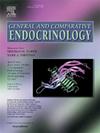Urotensin II in GIFT Nile tilapia (Oreochromis niloticus): CDS cloning, tissue distribution, and in vitro regulation of male reproduction
IF 1.7
3区 医学
Q3 ENDOCRINOLOGY & METABOLISM
引用次数: 0
Abstract
The caudal neurosecretory system (CNSS), present in all jawed vertebrates, except sarcopterygians, is considered a major site of urotensin II (UII) secretion. UII, a 12-amino acid peptide with a conserved hexapeptide ring structure, is also secreted by other tissues and found in sarcopterygians. UII has been associated with endocrine regulation, osmoregulation, and several pathophysiological conditions. In this study, CDS of GIFT Nile tilapia (Oreochromis niloticus) UII (tUII) and its receptors UT1 (tUT1) and UT2 (tUT2) were cloned from the CNSS and cerebellum, respectively. Phylogenetic analysis indicated that tUII, tUT1, and tUT2 shared a high homology with the ones of cichlid species, Haplochromis burtoni and Neolamprologus brichardi. Despite variations in precursor peptide sequences, the core sequence of the mature UII peptide remains highly conserved. tUII was predominantly expressed in the CNSS, while tUT1 and tUT2 were widely distributed in the central nervous system (CNS) and peripheral tissues of male and female tilapia. Functional studies revealed that synthetic tUII significantly activated luciferase activity in HEK293T cells transiently transfected with pNFAT-TA-Luc vectors and tUT1 or tUT2. In vitro studies in male GIFT Nile tilapia showed that tUII stimulated mRNA expression of gnrh1, gnrh2, and gnrh3 in a dose-dependent manner by brain fragments, as well as fshβ, lhβ, and gthα by primary culture of pituitary cells. Furthermore, tUII promoted the expression of gnrhr1, gnrhr2, and gnrhr3 in pituitary cells and stimulated mRNA levels of fshr, lhr, arα, cyp11b2, and dmrt1 in testicular tissue. All these stimulatory effects of tUII on gene expression mentioned above were blocked by the non-selective UT antagonist urantide, suggesting for the first time that the actions of tUII were mediated via tUT1 or tUT2. In addition, tUII could significantly stimulate the secretion of testosterone by testis fragments. Taken together, these results suggest that tUII may play a role in reproductive regulation in male GIFT Nile tilapia.
GIFT尼罗罗非鱼(Oreochromis niloticus)的尿紧张素II: CDS的克隆、组织分布和雄性生殖的体外调控。
尾侧神经分泌系统(CNSS)存在于所有有颌脊椎动物中,除了肉螯动物,被认为是尿紧张素II (UII)分泌的主要部位。ii是一种12个氨基酸的肽,具有保守的六肽环结构,也由其他组织分泌,存在于肉鞘中。ii与内分泌调节、渗透调节和一些病理生理条件有关。本研究分别从CNSS和小脑克隆了GIFT尼罗罗非鱼(Oreochromis niloticus) ii (tUII)及其受体UT1 (tUT1)和UT2 (tUT2)的CDS。系统发育分析表明,tUII、tUT1和tUT2与鲷鱼种、波顿单色鱼(Haplochromis burtoni)和布氏新虾(Neolamprologus brichardi)具有高度同源性。尽管前体肽序列存在差异,但成熟ii肽的核心序列仍然高度保守。tUII主要表达于CNSS,而tUT1和tUT2广泛分布于雌雄罗非鱼的中枢神经系统(CNS)和外周组织。功能研究显示,合成tUII可显著激活瞬时转染pNFAT-TA-Luc载体和tUT1或tUT2的HEK293T细胞的荧光素酶活性。对雄性GIFT尼罗罗非鱼的体外研究表明,tUII通过脑片段刺激gnrh1、gnrh2和gnrh3 mRNA的表达呈剂量依赖性,通过垂体细胞原代培养刺激fshβ、lhβ和gthα mRNA的表达。此外,tUII可促进垂体细胞中gnrhr1、gnrhr2和gnrhr3的表达,并刺激睾丸组织中fshr、lhr、arα、cyp11b2和dmrt1的mRNA水平。上述tUII对基因表达的刺激作用均被非选择性UT拮抗剂urantide阻断,首次提示tUII的作用是通过tUT1或tUT2介导的。此外,tUII可显著刺激睾丸碎片分泌睾酮。综上所述,这些结果表明,tUII可能在雄性GIFT尼罗罗非鱼的生殖调节中发挥作用。
本文章由计算机程序翻译,如有差异,请以英文原文为准。
求助全文
约1分钟内获得全文
求助全文
来源期刊

General and comparative endocrinology
医学-内分泌学与代谢
CiteScore
5.60
自引率
7.40%
发文量
120
审稿时长
2 months
期刊介绍:
General and Comparative Endocrinology publishes articles concerned with the many complexities of vertebrate and invertebrate endocrine systems at the sub-molecular, molecular, cellular and organismal levels of analysis.
 求助内容:
求助内容: 应助结果提醒方式:
应助结果提醒方式:


